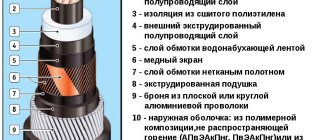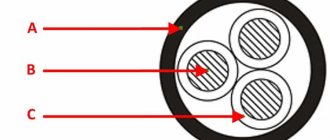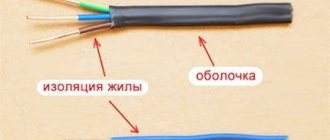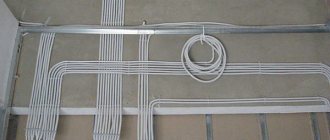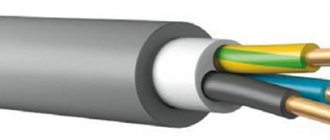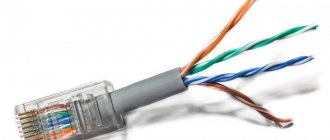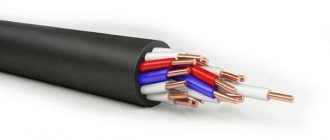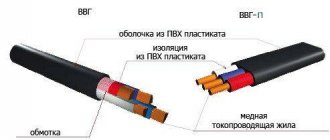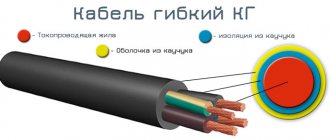Today there is a huge selection of cable products, and not even all electricians can thoroughly understand their designations and names without special literature.
The first question that arises before a consumer who decides to repair the electrical wiring at home is which cable should I choose? Let's consider only those types of cable that most often need to be used when installing and replacing electrical wiring inside an apartment or house. Finding them in construction stores is not difficult.
However, when purchasing, you must know exactly what their letters in the abbreviation mean, when you need to use one or another brand, and whether it is possible to replace one cable with another if one of the types is not on sale.
Cable VVGng and VVGng-LS differences
The first most common and most correct cable option is VVGng and its variety VVGng-LS. The cable has the following design:
It can be single-core or multi-core. In this case, the conductor was single-wire up to a cross-section of 25mm2. Most often it has a flat shape, which is very convenient when placing it in a narrow groove in a vertical position.
And in plastic cable channels it is convenient to lay wires of this particular shape. At the same time, do not forget that there should still be 40% free space in the cable channel after installation.
Core cross-section
Unlike VVGng-LS, the VVGng cable has a smaller core cross-section, exclusively in relation to four-core and five-core power conductors. For example, four-core VVGng-LS has a cross-section of 70 mm2, and VVGng - 90 mm2. The same, but already five-core conductors, have the following cross-sections - 185 mm2 and 120 mm2, respectively.
Explanation of the name
First of all, let's decipher all the letters in the abbreviation. Many people often wonder what they mean?
In the first
means that the insulation is made of polyvinyl chloride material
In the second
The cable sheath is also made of polyvinyl chloride insulation
G
cable Bare, without any protective armor covering
Just to remember, electricians call it among themselves:
Vinyl-Vinyl-Naked
Some brands after VVG have additional letters in their names:
P
stands for “flat”
ng
means that the cable is not flammable, although it would be more correct to say “non-flammable”
A
the cable is not flammable even when laid in bundles
Non-flammable due to the use of special insulation that does not support combustion, both the main core and the outer sheath. During a short circuit, such insulation envelops the wires and prevents them from burning.
Many people mistakenly talk about adding a chalk mixture to the insulation of the cores of a given cable, supposedly to reduce flammability. There's no chalk there.
Only dye is added to the insulation itself, otherwise you won’t get a quality product.
The only purpose for which a chalk-filled mixture can be used is exclusively to separate the insulation from the shell.
To do this, the veins are pre-rolled in a chalk bath during the production process. In addition, this technology helps prevent the cores from sticking together inside the shell.
Remember that the property of not burning a cable is only part of the task. It is necessary that the fire dies out and dangerous combustion products do not spread, and for this it is necessary to displace oxygen from this very zone. The PVC casing of VVGng-LS contains chlorine and other additives that perform this function.
It is because of this that the VVGng-LS brand is primarily recommended for installing wiring inside a house, office, or apartment.
L.S.
this is an abbreviation for Low Smoke, that is, low smoke and gas emissions
Price policy
Of course, price is the main difference and the reason for choice. Pricing depends on the quantity and quality of materials used. In the case of the power cables under consideration, high-quality materials are used, up to tubular PVC braid, but their quantity is different. In the case of VVGng-LS there are more of them, and the production method is more complicated. These two factors influence the price, which, by the way, is higher, by approximately 12%, in relation to the above-mentioned VVGng.
VVGng(A)-LS
Specifications
All technical data of the most used cable sections VVGng-LS, such as rated current, weight, resistance are presented in the tables below:
One important tip - even if you don’t yet have a grounding wire in your house and the system is TN-C and not TN-CS, still always buy only a three-core cable.
This way you won't have to redo all the wiring if you change your grounding system. Well, as a last resort, the third core will always remain a backup if a break occurs on the phase or neutral wire.
Tips for choosing
When going to the market for such a cable, be careful, since most of the products that sellers call the domestic analogue of NYM wire are fake. This is evidenced by the lack of necessary markings. When choosing a cable, pay attention to the logo and markings shown. Reliable and trusted manufacturers always put their own markings on the product. This already provides some kind of guarantee that the manufacturer is not afraid to bear responsibility for the products produced and is confident in their quality.
Sales consultants or ordinary market traders may recommend that you purchase SHVVP or PVS wires, stating that they are an excellent analogue of the NYM cable. You should not fall for such tricks, since in the case of SHVVP and PVS we are talking about ordinary cords. The main characteristic that distinguishes a cord from a cable product is related to its operational capabilities. The first is often suitable exclusively for switching household appliances and equipment, and the second is for connecting all wiring and more complex equipment.
Be sure to choose a cable with a grounding, yellow-green conductor, which will allow you to ensure high safety when operating equipment and home wiring. When choosing a product cross-section, you need to be guided by simple and general rules. When connecting lighting systems, it is enough to use wires with a cross-section of 1.5 square meters. mm, socket or switches - 2.5, oven or electric oven - from 4.5 sq. mm.
Despite the numerous domestic factories that are trying to produce high-quality NYM cable, in this case it is best to give preference to foreign factories from Germany, France or Turkey. Who knows, perhaps in a few years the situation will change, but for now we are forced to state this sad fact. In terms of operation, NYM is only suitable for internal single gasket applications. The product does not support any other options: you should not be fooled by the persuasion and deception of sellers!
Residential use
People often wonder, is it possible to use a simple VVGng, without the LS index? The rules, which have changed significantly in recent years, say that for installation inside residential premises, simple VVGng is prohibited.
This brand can only be used outside the building. See GOST 31565-2012 –.
This is explained by the fact that although it does not burn, under the influence of a flame it releases a huge amount of toxic substances. But it is because of combustion products, and not from fire, that most people die in fires.
Advantages
Any of the compared samples has certain advantages and should be used based on the characteristics of the structure for the communication of electricity.
NYM has the following advantages:
- a certain filler ensures high plasticity and reliability of the product;
- additional rubber insulation provides maximum moisture protection;
- ease of installation due to simple cutting;
- easy sealing of the input due to the cross-section of a regular circle;
- presentable appearance;
- durability.
VVGng is different:
- the ability to use different temperature conditions;
- resists burning when laid in groups;
- Thanks to the shell, it is not susceptible to ultraviolet radiation;
- cheaper.
NYM cable differences
The next brand suitable for indoor wiring is NYM cable. This designation is international and came to us from Germany.
The letter N (Normenleitung) means compliance with the German VDE standard - the union of German electricians. Y (Isolierung der Adem aus Polyvinylchlorid) – core insulation material is polyvinyl chloride, just like VVG. M (Mantelleitung) – installation cable with a protective sheath for installation inside buildings and structures
There are also similar names NUM and NUM. These are not fakes at all, as they might seem at first glance. They are produced by the same factories according to their own technical specifications, but without a VDE certificate.
Technical specifications:
NYM can be called a foreign analogue of VVGng, although another brand, VVGz, is closer to it. “Z” is a placeholder.
How to decide on the manufacturer
When considering NYM or VVGng options, you need to understand such an important point as the quality of production. NYM, presented on our market by domestic manufacturers, practically does not meet high foreign standards. Therefore, the technical characteristics declared by them do not correspond to this quality standard.
Cases when, according to customer reviews, they acquire an outright defect are not uncommon. Therefore, when it is necessary to purchase cable products, it is very important to choose cable products from the best manufacturers so as not to experience problems when repairing or constructing electrical wiring.
Foreign representatives have undoubted advantages in cable production, but the high price of the product restrains mass demand. Russian competitors offer a wide selection of these products; most successfully combine compliance with necessary requirements and affordable prices. At the same time, some companies are not inferior to foreign ones in their technological equipment. Such organizations value their reputation, which is based on positive consumer reviews of their electrical products.
What is the difference between NYM and VVGng
Here are the main differences between the two cable brands:
- firstly it has triple insulation
The third intermediate layer, in addition to fire-fighting properties, also restrains mechanical stress between the external insulation and the conductors. This prevents the formation of cracks on them.
True, the manufacturer himself does not consider this third layer of extruded rubber mixture to be insulation. And judging by the test voltage, the insulation itself is somewhat inferior here:
VVGng - test voltage - 3 kV NYM - test voltage 2.5 kV
- secondly, its insulation is gray, while that of VVG is black
For many, categorically black may not be suitable for aesthetic purposes.
- thirdly, it is always round in shape
A plus that few people think about, but the rounded shape of NYM makes it easier to seal the input of this cable into various devices, junction boxes and cabinets.
- and most importantly, the NYM cable is suitable for fire safety for indoor premises only when installed individually!
If you want to lay it in bunches of two or three pieces in one groove or channel, you will have to use the NYMng (A)-LS modification
Just don’t be confused, single NYMs, each laid in a separate corrugation, and running along the surface of a wall or ceiling next to each other, are not considered a bundle. This is exactly how many electricians get around the ban on group installation of wiring of this brand.
Comparison of parameters
It is more clear to compare data by combining the information in one tabular form.
| Technical characteristics, standard size 3x4 | Meaning for | |
| NYM | VVGng | |
| Rated AC voltage with a frequency of 50 Hz, V | 660 | 660 |
| Temperature | ||
| Range of normal cable operation, °C | -50 ÷ +50 | -50 ÷ +50 |
| Maximum permissible temperature, no more, °C | 70 | 70 |
| Emergency long-term, no more than 8 hours, increase no more than °C | 80 | 80 |
| Permissible during short circuit for up to 4 sec, no more, °C | 160 | 160 |
| Air temperature at which installation without preheating is allowed, no colder, °C | -5 | -15 |
| Trial | ||
| Test voltage, V | 2000 | 3000 |
| Test time, min | 5 | 10 |
| Mechanical | ||
| Nominal insulation thickness | 0.8 | 0.7 |
| Nominal thickness of intermediate layer | 0.4 | No |
| Nominal Sheath Thickness | 1.6 | 1.5 |
| Weight of 1 kilometer of cable | 270 | 194 |
| Cable cross-sectional shape | Round | Round Flat |
| Permissible bending radius, outer diameters of the cable, no more than times | 4 | 7.5 |
| Possibility of sealing when entering equipment | Yes | No |
| Does not spread fire during installation, | Single | Group |
| The ability of the cable to draw in water, hygroscopicity | No | Yes |
| Sheath resistance to ultraviolet radiation | Below | Higher |
| Convenient cable termination | Higher | Below |
| Outer shell color | Light gray | Black |
| Nominal service life, not less, years | 30 | 30 |
| Price | Higher | Below |
There are differences in characteristics across many positions. The question of whether to purchase an NYM or VVGng cable cannot be resolved without a careful comparison of the inconsistencies that give different properties during installation and operation:
- Almost identical temperature ranges. The difference is that the plastic compound allows laying VVG without preheating at a lower air temperature, -15°C. NYM composite rubber does not allow operation below -5 degrees;
- Electrical tests of domestic products are more severe. 3000 volts for 10 minutes, versus 2 kV for 5 minutes. The testing requirements are explained by the thick insulation and sheath of the imported cable, and the presence of an additional middle layer of protection. These circumstances influenced weight gain;
- Soft vinyl and a layer of elastic rubber increased the flexibility of the NYM. This allows it to be laid individually with a smaller radius, making it easier to work on curved sections of the route. Of great importance is the ability to seal the insertion points of the shell in explosive areas. Rigid VVGng with a shell made of modified plastic has high fire-fighting properties, allowing for laying in bundles. Unlike its European counterpart, it is easier to withstand laying without UV protection outdoors;
- A layer of coated rubber, providing tightness, allows use in very wet places. It also makes it easier to cut NYM ends during installation. The subjectively more pleasant light color of the hose is easily marked with a felt-tip pen or marker when laying;
- The cost of VVGng is lower.
Selecting a cable for a specific application must take into account the features, characteristics, locations and installation conditions.
Cable laying features
Of course, this wire does not spread combustion, but this does not mean that it does not burn at all.
Here is a demonstration video about the simultaneous testing of the flammability of two brands when exposed to an external flame. It immediately becomes clear why NYM cannot be laid in bundles and together with each other.
Another feature of this brand, which at the same time can be its disadvantage, is that the cable insulation is afraid of ultraviolet rays. That is why it cannot be laid outside.
VVGng has greater opportunities here. It can be easily used both inside and outside the building. For example, as an input from a pole to a house, or a branch after a SIP wire.
A close relative of NYM, which can be used outdoors and outdoors, since its insulation is no longer afraid of ultraviolet radiation, is the MMJ cable.
Why do many still choose NYM given its relative disadvantages? This is explained by the great convenience when laying it - it is easier to clean, bends at turns, and does not get stuck when pulled through pipes and corrugations.
For a flat VVG cable, you need to make sure that it does not get twisted, but with a round NYM there are no such problems.
Life time
The estimated service life of VVG and NYM cables is at least 30 years.
At the same time, the wording “not less” means that if this cable is under 100% load in unfavorable conditions, it must work for AT LEAST 30 years.
And if there are the most ordinary conditions and the absence of a nominal load, then maybe all 50! It is these two main brands of cable, discussed in detail in the article, that are the most suitable and popular for installing electrical wiring, connecting sockets, switches and lighting.
There is another brand different from the two above that you may need in small quantities. But this is not a cable, but a wire - PV-3.
It is flexible, multi-core, easy to bend in small spaces and convenient to connect to machines via NShVI lugs. That is why it is used in the assembly of electrical panels.
Well, in the end, we will give a decoding of all the meanings of the letters in the cable brands, which are widely applicable in our electrical networks.
conclusions
Let's try to highlight the bright advantages of each manufacturer. Pros of NYM:
- A special filler makes the wires very durable; thanks to their plasticity, they are protected from damage;
- No problems with cutting and installation;
- Aesthetic appeal and long service life.
Pros of VVGng:
- Possibility of operation in a wider temperature range;
- Thanks to the dense shell, it is resistant to UV rays;
- Democratic price.
It can be noted that VVGng is more preferable - after all, there are many reviews about its analogue, indicating the dubious quality of the product. But in general, future operating conditions should be taken into account so as not to make a mistake with your choice.
Which wire is better - the materials from which electrical cables are made
Anatomy of a wire
The main elements that make up the wire of an electric cable are the cores - elements for the passage of electric current, isolated from each other by an internal sheath and enclosed in a common sheath.
They are designated by the abbreviation TPG.
There are two types of such conductors for transmitting electrical energy:
- single-wire solid;
- stranded, consisting of a large number of thin threads.
There are two concepts that can be easily confused with each other: solid cores and solid cables. In fact, these are different things. Single-core products can have only one core, which, in turn, can be made single-wire or multi-wire.
The main material for the manufacture of current-carrying conductors: copper or aluminum. If we compare these metals, then aluminum, although it is cheaper, loses in that it has a lower level of electrical conductivity.
This means that with an equal cross-section, a copper conductor is capable of passing more current. The only drawback of copper is that it cannot be directly combined with other metals. Therefore, if you need to connect a copper wire to aluminum, you will need an adapter that eliminates the formation of a galvanic pair.
If the wires are connected by twisting, this place will quickly oxidize, which will lead to a break in the contacts, and the result may be a short circuit in the line. Therefore, ideally, select wires of the same type for all lines in the apartment.
Cables for electrical signals are equipped with a common protective sheath.
VVG-Png
This type of conductor product is used in environments where the possibility of fire spread must be minimized. The prefix “ng” in the designation VVG-Png means that the materials used in its manufacture do not support combustion.
Voltage and frequency specifications are generally accepted and are 660/1000 V at 50 Hz. Conducting copper conductors have a round cross-section, but are laid not in a concentric way, but in a row, in one plane (“P”). Their number

